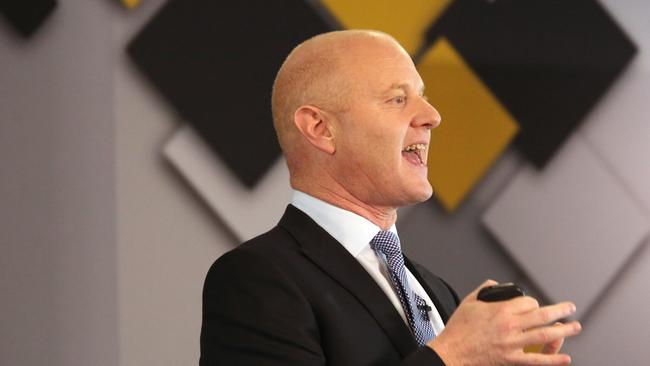CBA’s Narev breaks silence on rates
Ian Narev flagged the limits of RBA rate cuts, launching a vehement defence of CBA’s policy.

Commonwealth Bank chief Ian Narev has flagged there is only so much official rate cuts can do, as he issued a fierce defence of the decision to hold back half of the Reserve Bank’s reduction from mortgage holders, arguing the lender’s deposit customers and shareholders were not the “elite of Australia” who had instead benefited.
Reporting a 3 per cent rise in cash profit to a record $9.45 billion — the slowest growth since the global financial crisis — Mr Narev told investors today that while the economy remained in a relatively “favoured” position, the dive in commodity prices was weighing on growth and borrowers were “hesitant to respond” to the RBA’s monetary policy as strongly.
“We are seeing examples hear of the global phenomenon where fragility in the global economy, concerns about the global geopolitical environment, creates a lack of confidence which monetary stimulus cannot fully offset,” he said, after the RBA last week cut the cash rate to a record low 1.5 per cent.
Falling interest rates crunch banks’ margins as profits from deposits and equity slows, a problem faced by many banks in other countries where official rates are near zero.
“So we’re expecting over the next 12 months pretty much an economy that feels like more of the same, but we do see risks to the downside if levels of confidence driven by external events go down and that continues to keep confidence low,” Mr Narev continued.
“In this sort of environment, we do need to be a bit more conservative.”
For the year to June 30, CBA’s total dividend of $4.20 was flat for the first time since 2009 after the second payment of $2.22 was also steady on last year. In recent trading, shares in CBA — the nation’s biggest lender — were down 0.9 per cent at $77.71 as analysts said the bank’s second half was weak and asset quality was deteriorating .
In his first comments since CBA last week held back half of the RBA’s cut from mortgage holders but raised a range of term deposit rates, Mr Narev said he understood the bank’s two million home loan customers wanted to pay as little interest as possible.
But CBA’s 11 million depositors and 800,000 direct shareholders — plus millions who own shares via their superannuation funds — also wanted to earn more interest and have confidence in their income from dividend payments.
“Just like the home loan customers, these are Australians from all walks of life. This is not the elite of Australia,” he said.
“So we hear from our deposit customers, 75 per cent of whom are aged over 55, that the low interest rate environment has caused them real pain in their income and is actually affecting their day to day decisions on what to spend.
“We also hear from the Australian households who own our shares how important some degree of security of the dividend is to them.”
Including people who own CBA shares through super funds, Mr Narev claimed Australians had $100bn invested in the bank and the average small retail shareholder will get around $3500 in dividends this year.
“So when we face these decisions, our job is to balance the interests of borrowers who would prefer to pay less with depositors who would prefer to earn more interest with shareholders who are looking for some degree of stability on the dividend,” he said.
“Economic stimulus occurs when all those things can happen to the maximum extent possible.
“Our job is to continue to achieve that balance. Sometimes we’re going to be unpopular by doing it, but the alternative is to have a weaker bank and a weaker economy.”
For the year, CBA’s key profitability metrics weakened as the bank’s net interest margin fell two basis points to 2.07 per cent while return on equity slid 170 basis points to 16.5 per cent. Mr Narev added that conditions were more difficult in the second half to June 30, when profit fell 3 per cent as all divisions suffered either flat or falling earnings.
“(It was a) soft half from CBA. Weak revenue trends across many divisions. Good to see a response on costs. But deteriorating asset quality trends are now clearly in place,” UBS analyst Jonathan Mott told clients.




To join the conversation, please log in. Don't have an account? Register
Join the conversation, you are commenting as Logout